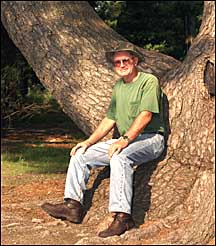|
|
|
|
|
July 26, 2002Campus arborist watches out for trees
His clean heather T-shirt on this sticky July morning pretty much says it all: "Relax, I'm a Professional." Jim Callahan is Iowa State's full-time arborist -- tree specialist -- and it doesn't take long to grasp that he enjoys his work and wears an honest shirt. His easy-going Irish manner puts you at ease and the fistful of photos and documents he has brought with him are proof that he understands trees, healthy or not. For the record, an arborist's job is about trimming, treating and monitoring trees. Callahan is the first to admit he spends chunks of his time simply looking at trees -- assessing potential problems, looking for growth patterns that typify healthy or unhealthy trees. He said he also relies on groundskeepers to alert him to weak trees and other problems. Callahan is the guy who has to determine a tree's liability to the university, no matter its age or height. For example, he recently removed one in a pair of old white pines from the lawn east of the campanile when he discovered a dangerously hollow trunk. Of the 3,000-plus American elm trees that once thrived on the ISU campus, just 15 remain. Callahan treats those 15 each spring to keep them healthy and the European Elm beetle at bay. At 62, Callahan is still the only guy on campus certified to climb trees, when his state-of-the-art bucket truck isn't quite enough to get him where he needs to be. But to a tree trimmer who trained on 250-foot eucalyptus trees in southern California, most specimens on campus and at Veenker golf course aren't daunting. Callahan also is licensed in integrated pest management (selecting predator insects to eliminate other, undesirable insects) and in spray application techniques. (At ISU, spraying gets done between midnight and 6 a.m. to give things time to settle and avoid any ill effects on students and employees.) Three years ago, Callahan led the effort for an Arbor Day observation in the university's arboretum. It involved area grade-school children and the local chapter of Trees Forever. Since 1999, it has involved different funders and planters, but the tradition continues. "I just felt this was something the arboretum needs -- and I wanted to bring some attention to Arbor Day," he said. But Callahan makes time for more than just tree care. He works with campus landscape planners Rick Fox and Cathy Brown to place campus trees on the state's historic registry. (The Department of Natural Resources -- DNR -- keeps a list of the oldest and the largest in each species.) For example, the largest English Oak in the state stands near the southwest corner of LeBaron Hall. "We're trying to get three or four more on the list, including a Tree of Heaven, Chinese Lilac, Paper Bark Maple and a Lace Bark Pine," he said. "They (Brown and Fox) select them and I follow up with the research and paperwork." Callahan works intermittently with ISU plant pathologists and entomologists on specific research projects of interest to each of them. He also was part of the team that in 1993 received the first DNR grant to a university to set up a composting site for yard waste. The site is off State Street, south of the arboretum. Rather than pay $35,000 each year in landfill fees for yard waste, the university started making its own "black gold," Callahan said. From southern Cal to central Iowa Born in Iowa's Lucas County, Callahan grew up, from the age of 10, in the Los Angeles suburb of Whittier. He started college with the intent of majoring in soil science, with minors in horticulture and arboriculture. But after two years at a local junior college and a year at California State Polytechnic University, and newly married to his wife, Margaret, he said he decided he could earn more as a tree trimmer than if he finished his degree. He trimmed trees for the city of Whittier for two years and credits his superintendent, Walter Barrows, with educating him well and preparing him for bigger opportunities in the future. From 1964 to 1980, he owned and operated Callahan Tree Trimming, a thriving and steadily growing operation. He merged with another tree trimmer in 1980 to form Golden Bear Arborists, at the time the largest tree-trimming operation in southern California. They landed big contracts with cities such as Beverly Hills, grew to more than 100 employees and ran up $4,000 monthly bills at the area landfill. But bigger also brought more headaches. "I learned bigger isn't always better. I'm an Irish boy who likes smaller things, I guess," Callahan said. Late in 1982, he sold his half of Golden Bear to his partner and resumed Callahan Tree Trimming. By the late 1980s, Callahan said the smog and large population in the L.A. area started to take its toll. He grew weary of two-hour, 30-mile commutes to job sites and started thinking about a simpler lifestyle. In January 1989, he sold his tree-trimming equipment and all his contracts and opted to move to Iowa, where his parents were now retired and the smog levels are negligible. Later that fall, by chance, Iowa State advertised for a tree trimmer. Callahan applied and got the job and moved his family to 12 acres of land southwest of Boone. "I had a lot to learn, coming to Iowa from southern California," he recalled. "Every climatic zone has its own species, so I went from eucalyptus there to pine and oak here." When the campus arborist position opened, Callahan was able to prove, during a series of interviews, that he had the knowledge and experience to do the job. "I really enjoy my work here," he said. "I get into so many things." |
|
Ames, Iowa 50011, (515) 294-4111 Published by: University Relations, online@iastate.edu Copyright © 1995-2001, Iowa State University. All rights reserved. |
